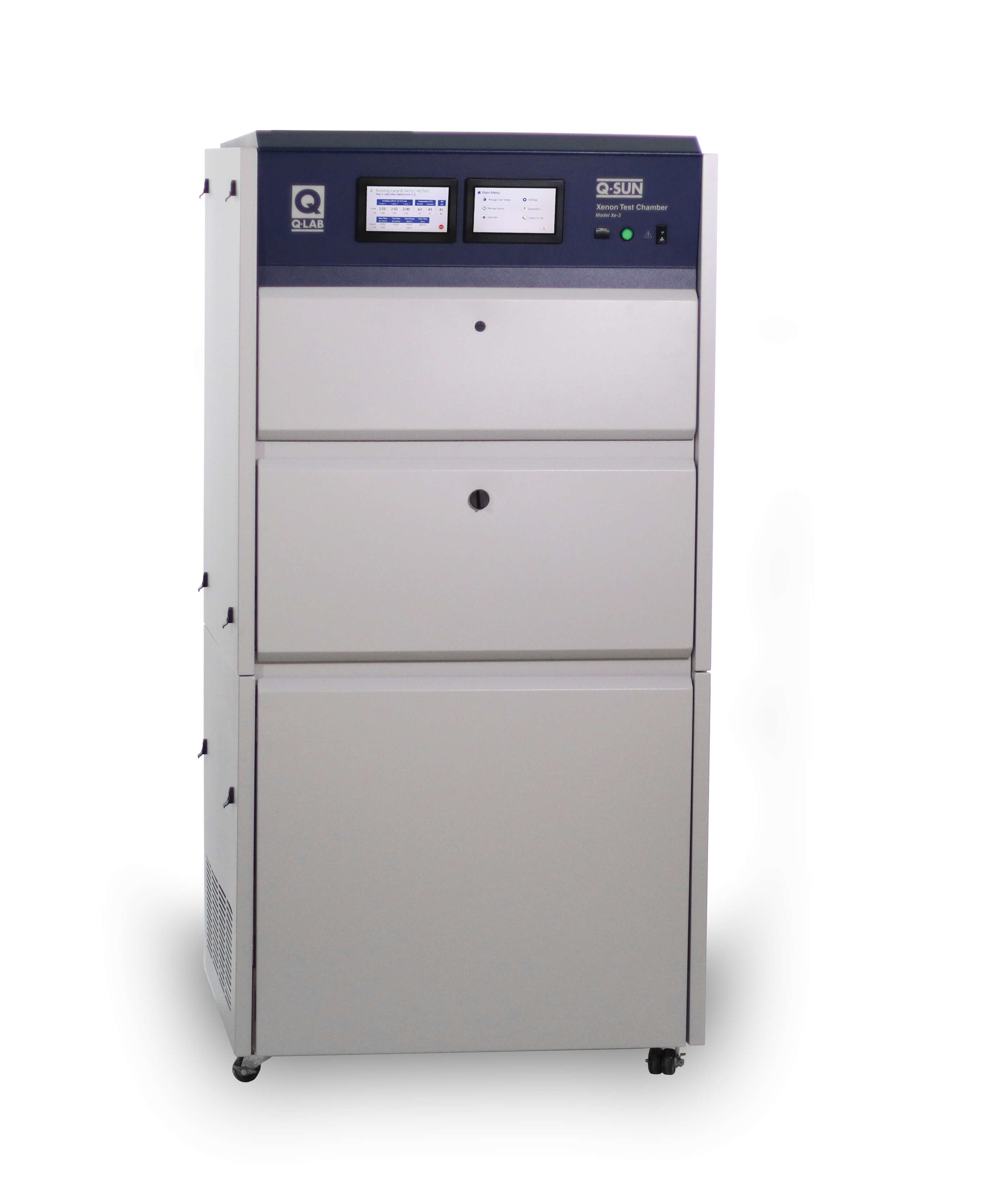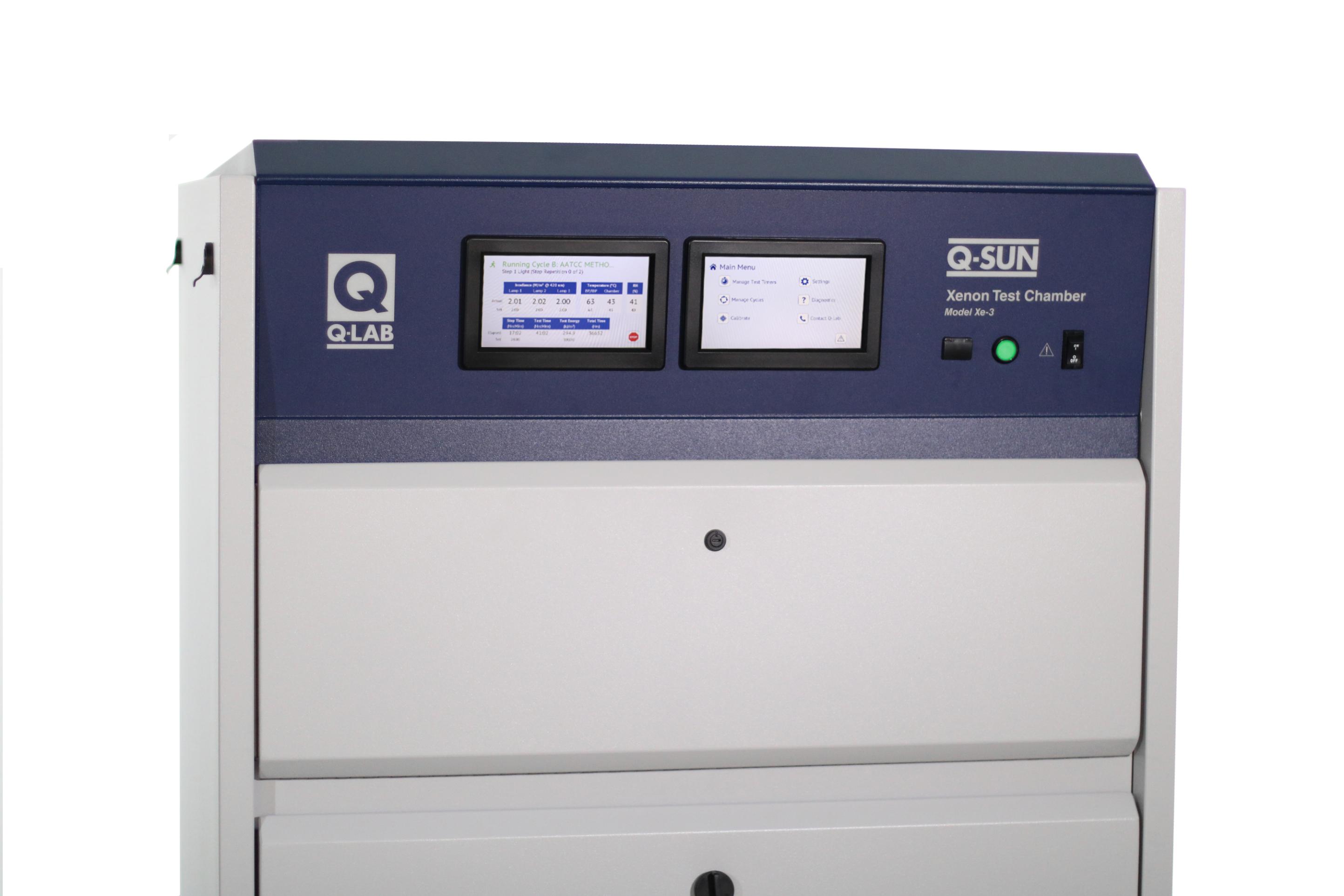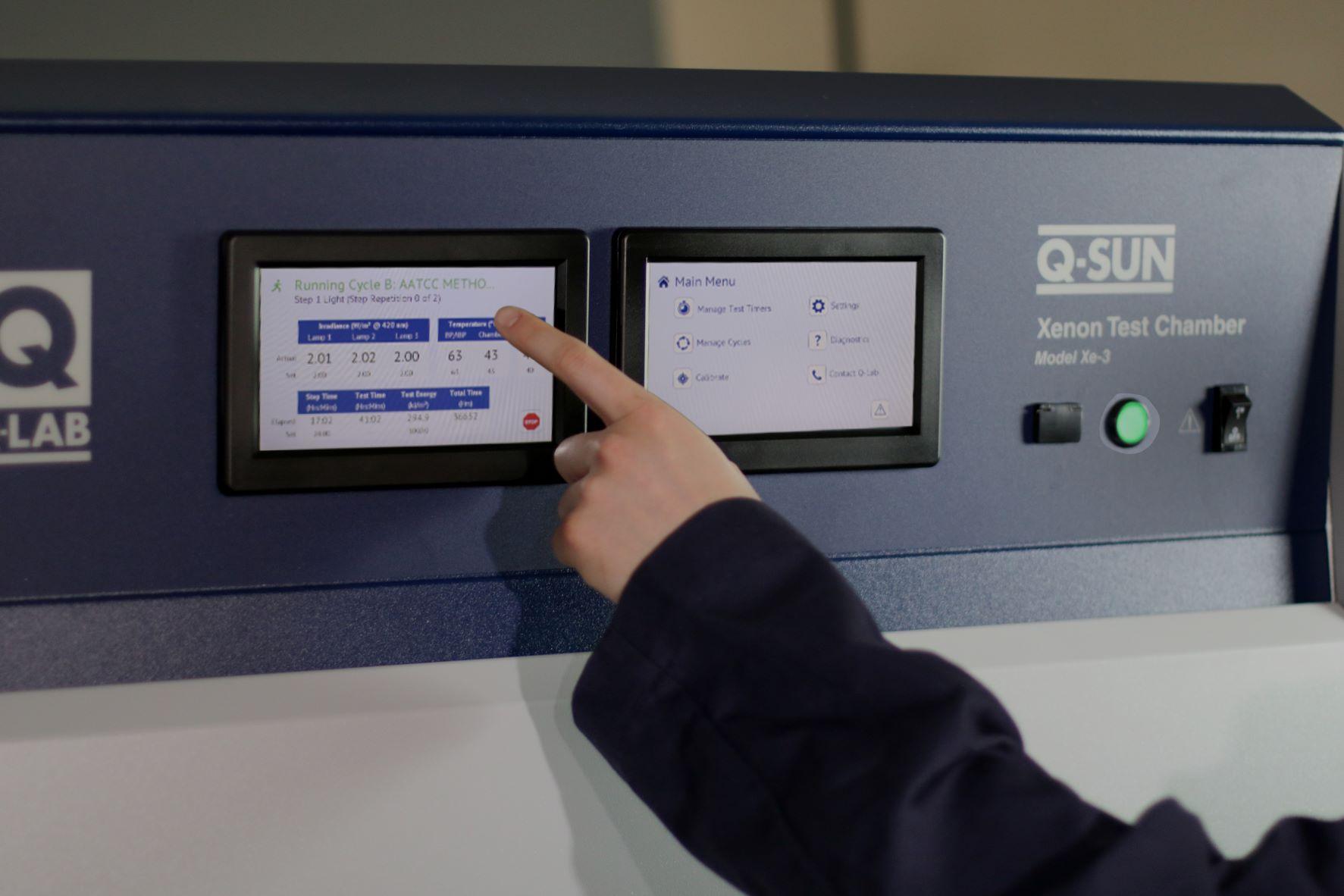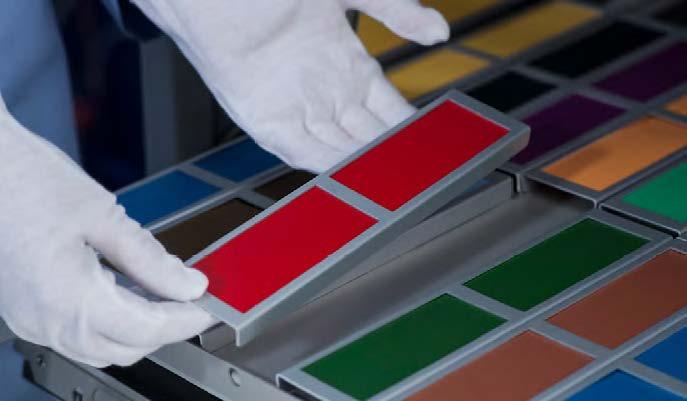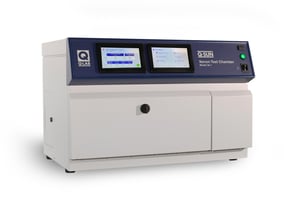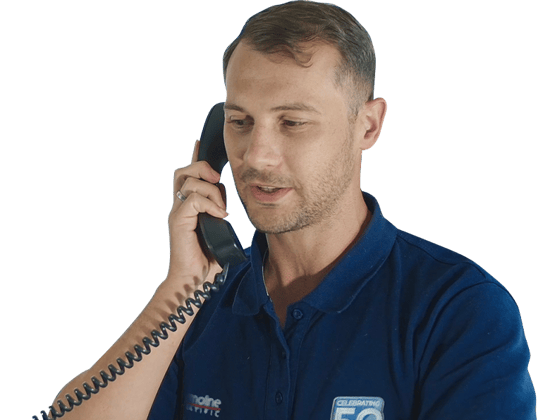Q-SUN Xenon Arc Flat Array Weathering Tester XE-3
The Q-Sun Xe-3 xenon arc chamber reproduces the damage caused by full-spectrum sunlight and rain. In a few days or weeks, the Q-Sun tester can reproduce the damage that occurs over months or years outdoors.
The Q-Sun Xe-3 tester is a full-featured lightfastness, colourfastness, and photostability chamber at a breakthrough price.
Overview
The Q-SUN Xe-3 tester’s slide-out specimen tray is 451mm x 718mm and is useful for exposing large, three-dimensional parts or components. Its xenon arc lamps provide the best match to the full spectrum of sunlight. Near-horizontal specimen mounting and optional water and back spray give the most realistic moisture simulation available in a xenon arc tester and an optional chiller for low-temperature applications.
A product exposed outdoors to direct sunlight experiences maximum light intensity for only a few hours each day. The Q-Sun Xe-3 chamber can subject test specimens to the equivalent of noon summer sunlight for 24 hours a day, every day. Consequently, specimen degradation can be highly accelerated.
The Q-SUN testers’ xenon arc lamps produce the most realistic reproduction of full-spectrum sunlight, including ultraviolet, visible light and infrared radiation. For many materials, exposure to the full spectrum is necessary to provide an accurate simulation, especially when testing for colour change and lightfastness. The Q-Sun test chambers use air-cooled xenon arc lamps to significantly reduce operating and maintenance expenses. Lamp life is guaranteed for most Q-Sun models for 3000 hours at normal irradiance and 1000 hours at high irradiance.
A choice of optical filters is available to simulate a variety of service environments, including direct sunlight and sunlight through window glass. Q-Lab's filter performance does not decline with age; therefore, filters do not need to be replaced under normal operation.
- Daylight Filters are used to simulate direct, noon summer sunlight. They provide the best correlation to natural exposures for most applications. Materials that are typically used outdoors (e.g. roofing and exterior coatings) should be tested using daylight filters.
- Window Glass Filters produce spectra equivalent to sunlight coming through window glass. This spectrum can also simulate other indoor lighting, such as the harsh lighting found in a typical commercial or office environment. Window glass filters are used for indoor materials such as printing materials and textiles.
- Extended UV Filters allow excess UV below the normal cut-on of natural sunlight. They are used to produce faster or more severe test results. Extended UV Filters are specified in some automotive test methods and are sometimes used for aerospace applications.
Control of temperature is important because it influences the rate of degradation. Specimen exposure temperature is precisely controlled in the Q-Sun Xe-3 tester using a black panel temperature sensor. The temperature can be set at any point between 42ºC and 120ºC, depending upon whether the sensor is insulated or uninsulated, irradiance level, filter type, lamp age and ambient room temperature.
For some interior products, such as pharmaceuticals and cosmetics, lower exposure temperatures are necessary to prevent unnatural degradation. An optional chiller is available for the Xe-3 tester to lower temperatures when testing such heat-sensitive materials. With a chiller, a Q-SUN Xe-3 tester can operate at 31-120ºC and 50% RH, depending upon sensor type, irradiance level, filter type, lamp age, and ambient room temperature and humidity. The Xe-3 chiller is designed to stand alongside the full-sized Xe-3 tester and is provided with wheels for easy repositioning.
The SOLAR EYE irradiance control system constantly monitors and controls lamp output. This assures precise light exposure and maximises the reproducibility of test results. Irradiance control is available at 340nm, 420nm or TUV (Total UV).
Outdoor moisture attack is simulated via a pure water spray option in the Xe-3 tester. Two spray nozzles are located in the top of the chamber. Spray can be programmed to operate during either the dark or light cycle. Note that purified water is required for proper operation of the Xe-3 with water spray.
The Q-SUN Xe-3 is the only xenon arc tester that also has an optional dual spray capability. The dual spray feature allows a second liquid solution, such as acid rain or soap solution, to be sprayed onto test specimens. A large external reservoir, centrifugal pump and filter are attached to a portable cart that sits next to the Xe-3 tester.
Models
Q-SUN Xe-3-H: full-spectrum sunlight with humidity control
Q-SUN Xe-3-HSE: full-spectrum sunlight with humidity control, water spray, and dual touchscreen displays
Q-SUN Xe-3-HDSE: full-spectrum sunlight with humidity control, dual spray, and dual touchscreen displays
Q-SUN Xe-3-HBSE: full-spectrum sunlight with humidity control, water spray (front and back), and dual touchscreen displays
Q-SUN Xe-3-HCE: full-spectrum sunlight with humidity control, chiller, and dual touchscreen displays
Q-SUN Xe-3-HSCE: full-spectrum sunlight with humidity control, water spray, chiller, and dual touchscreen displays
Technical Data
-
BrandQ-Lab
-
Capacity55 Specimens (51 x 102 mm)
-
Temperature Range+45°C to +110°C (Light Cycle)
-
Electrical3ph/26A/415V
-
CastorsYes
-
Humidity Range20% to 95%
Support
At Thermoline, we strive to supply helpful customer support to ensure that you get the most out of our products. We are committed to providing whatever support our customers need, wherever they are in the world. If you can't find your solution in the below FAQs or Knowledge Base, please contact our friendly support team.
- What is the difference between UV and Xenon testing?
UV and Xenon testing are accelerated weathering tests commonly used to evaluate the durability and performance of materials, coatings, and products under exposure to sunlight and other environmental factors. However, there are some critical differences between these two types of testing.
UV testing typically uses specialised lamps that emit UV radiation at specific wavelengths, typically in the range of 280 to 400 nanometers. The lamps are arranged in a chamber designed to simulate the effects of sunlight, and the test specimens are exposed to the UV portion for a set period. UV testing is often used to evaluate the resistance of materials and is ideal for testing residual strength and polymer degradation in the form of gloss loss, strength loss, yellowing, cracking, crazing, embrittlement.
Xenon testing, on the other hand, uses a different type of lamp that emits light across the entire visible spectrum and some UV and infrared radiation. The lamps are typically arranged in a chamber designed to simulate both sunlight and humidity, and the test specimens are exposed to the light and humidity for a set period of time. Xenon testing is often used to evaluate the resistance of materials to colour fading, chalking, cracking, or other forms of degradation that can be caused by exposure to sunlight, heat, and moisture.
- Why do you need lab grade pure water for the water spray in a Q-Sun?
Impurities in water can leave deposits on test specimens, thus spoiling the opportunity to evaluate their appearance as degradation occurs. Also, the tester can suffer performance issues or mechanical breakdowns due to the prolonged deposition of impurities from water.
Q-Lab offers a water repurification system to significantly reduce the cost of running the Q-Sun tester’s optional water spray system. The system can save over 1,000 litres of expensive, purified water per day in a test cycle that calls for several hours of water spray and can pay for itself in a matter of months.
- How many hours in Q-Sun equals x-amount of years outdoors?
Weathering experts have tried to find that magic number for decades, but there is no such one. No matter how the question is formulated, the answer is always the same: “It depends!” It depends on one simple reason: Mother Nature is not as reliable as lab equipment!
There is no direct conversion between the hours of exposure in a Q-Sun tester and the amount of time spent outdoors, as the intensity of UV radiation and other environmental factors can vary widely depending on location, season, and weather conditions. So, unfortunately, there is no magic number that we can you that can tell you.
Q-Sun testers are designed to simulate accelerated aging under controlled conditions, and the results are intended to be used as a comparative tool to evaluate the relative performance of different materials or coatings. Outdoor exposure, on the other hand, is subject to a wide range of variables that are difficult to control or predict.
- What irradiance control point should I choose?
Weathering and lightfastness test standards typically specify an irradiance level as both a magnitude and the wavelength (or wavelength range) where it is controlled. Irradiance in fluorescent UV and xenon arc weathering testers can be controlled using narrowband or wideband setpoints.
The selection of a narrowband control point in a QUV fluorescent UV tester is determined by the UV lamp type in use. We suggest controlling a Q-Sun xenon arc weathering tester using a wavelength or wavelength region in which the test specimen is sensitive. If the user is primarily concerned with colour change, then a 420 nm control point is often used. If the primary area of concern is another type of physical property change, gloss loss, for example, then a 340 nm control point is frequently used. A wideband TUV control point (300-400 nm) can be viewed as a compromise between the two narrowband (340 nm & 420 nm) control points, as it uses the total irradiance over the range 300 400 nm as its setpoint.
The selection of optical filters in a xenon arc tester also usually parallels this selection of irradiance control point. Typically, users testing with daylight optical filters use a 340 nm control point, while users of window glass optical filters generally use 420 nm control point.
- Does Q-Lab’s fluorescent UV and xenon lamps meet International Standards for irradiance?
International standards for operating weathering test apparatuses using Fluorescent UV and Xenon Arc lamps often include requirements for relative spectral power distributions (SPDs) of the light sources. These SPDs define ranges for what percentages of a given light source’s irradiance fall within a specified bandpass, e.g. 290-320 nm or 360-400 nm.
Both ASTM and ISO standards provide important sets of SPD reference tables. Fluorescent UV spectral tables are provided in ASTM G154 and ISO 4892-3, while xenon arc requirements are found in ASTM G155 and ISO 4892-2. These tables are defined for three different general classifications of lamps and filters: Daylight (outdoor sunlight), Window (behind glass), and Extended UV (UVB-313).
Q-Lab’s UVA-340, UVA-351, and UVB-313EL lamps all meet the specifications of both ASTM G154 and ISO 4892-3 for Daylight, Window, and Extended UV.
The following Q-Lab UV filters used in Q-SUN weathering testers meet the spectral requirements specified in ASTM G155 and ISO 4892-2. The latter standard does not include a specification for Extended-UV.
Table 1 (Daylight filters): Daylight-B/B, Daylight-Q, Daylight-F
Table 2 (Window glass filters): Window-B/SL, Window-Q, Window-IR
Table 3 (Extended-UV filters): Extended UV-Q/B
The only Q-Lab standard optical filters that fall outside of these SPD requirements are the Extended UV-Quartz and the Window-SF5 filters. The Extended UV-Quartz filter is required only in a few specialty aerospace standards, while the Window-SF5 filter is used only in automotive standards specifying glass with higher cut-on wavelengths than architectural glass.
- Can the Q-Sun run “Solar Radiation” tests found in environmental testing standards?
- “Solar radiation” standards describe tests that are designed to characterise the performance of electronics subject to outdoor use or other harsh environments. The two most important solar radiation standards are MIL-STD-810G and IEC 60068 2 5. The Q-Sun product line can be used to meet these environmental “solar radiation” tests. A critical fact to note is that these standards are not specific test methods, despite having sections called “test methods.” Both standards spend considerable space discussing the concept of “tailoring”, which gives laboratories and engineers flexibility in designing tests that apply the environmental stresses discussed in each section. Thus not only are these standards performance-based in allowing multiple hardware designs, it is also possible to alter the actual test conditions if the result meets the general intent of the section. MIL-STD-810H clearly states:
“It is important to note that this document does not impose design or test specifications. Rather, it describes the environmental tailoring process that results in realistic materiel designs and test methods based on materiel system performance requirements.”
MIL-STD-810H and IEC 60068-2-5 both include numerous statements reinforcing this flexibility in selecting test conditions. In fact, the “solar radiation” tests in these standards are impossible to run in any chamber because they show a target spectral power distribution from 280 to 3000 nm, which no artificial light source can meet. Because no single light source actually meets the specification, the user of the standard must apply sound and reasonable engineering principles to tailor the test by defining how the relevant environmental stresses will be applied. Q-Lab has prepared two special letters confirming that Q-Sun xenon-arc weathering testers can meet the performance requirements of Method 505.7 of standard MIL-STD-810H, provided that the document’s guidance on “test tailoring” is followed. Laboratories who need to add these standards to their scope of accreditation need to write a procedure that addresses specifically what test tailoring they have selected for their Q-Sun. - What’s the difference between Narrowband and Wideband irradiance control?
In Xenon and UV fluorescent accelerated weathering testing, an irradiance setpoint value is an incomplete information without reference to the wavelength or wavelength range it represents. There are two classes of irradiance setpoints.
Narrowband irradiance setpoints include 340 nm and 420 nm, representing a 1 nm wide bandpass centred on the single wavelength value indicated (i.e. ½ nm on either side of 340 nm, for example). Narrowband irradiances use units of “Watts per square meter per nanometer.” This can be written as either W/(m2∙nm), W/m2/nm, or W∙m-2∙nm-1.
Wideband irradiance setpoints (usually “TUV” or “total UV”) are an integration of the irradiance from all wavelengths between two endpoints, usually 300-400 nm (accelerated laboratory) or 295-385 nm (outdoor). As a result, wideband irradiance values are generally much larger than narrowband irradiance values. Wideband irradiance is measured in “Watts per square meter,” written as W/m2 or W∙m-2.

